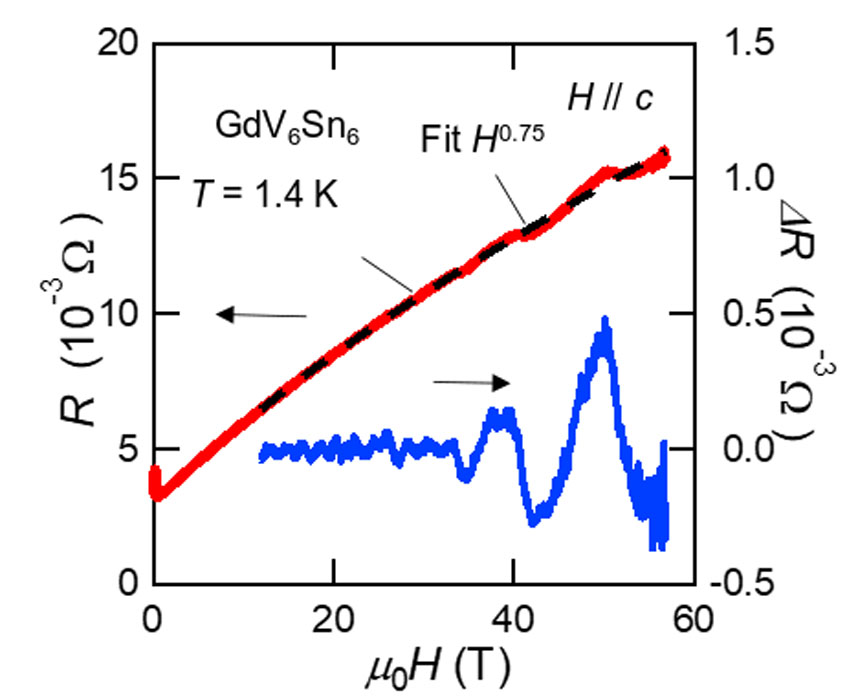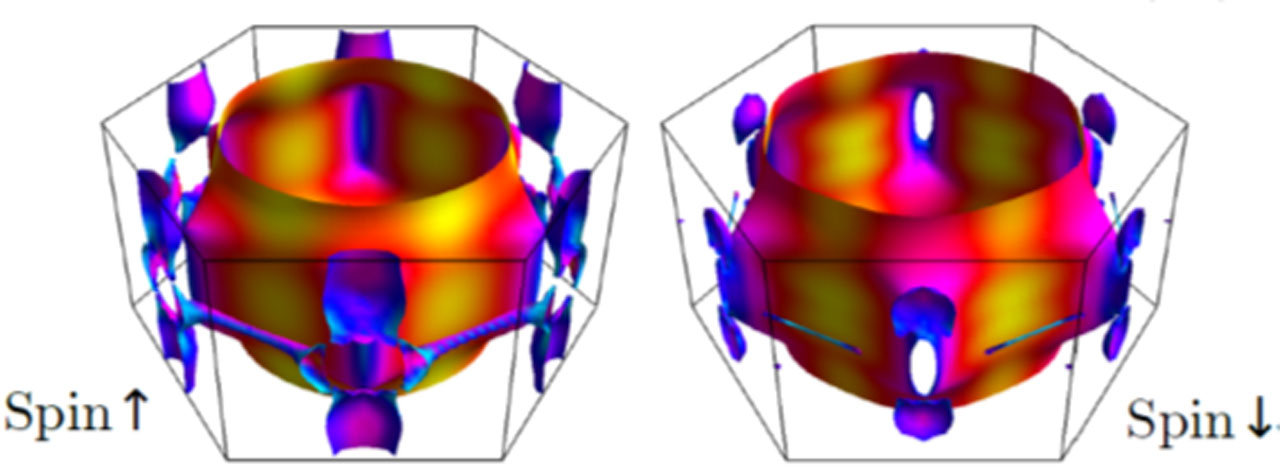New Material Exhibiting the Interplay between Non-magnetic 3d-electron Kagome Bands and 4f-electron Magnetism
Kindo, Ozaki, and Tokunaga Groups
Kagome lattice, a two-dimensional network made of corner shared triangles, has attracted condensed matter physicists as a platform for realizing novel electronic states. A localized spin system on the kagome lattice is a typical example that exhibits a quantum spin liquid ground state due to the geometrical frustration. Itinerant electrons on the kagome lattice produces a band structure with uncommon features such as a Dirac point, van Hove singularity, and a flat band and may host unconventional density wave orders or superconductivity. Experimentally, 3d transition metal compounds with kagome lattice have been investigated in search for novel correlated electronic phases. Kagome cuprates are candidates for the Mott insulator with a quantum spin liquid ground state. Intermetallic compounds with the kagome layers of Cr, Mn, Fe, and Co have been investigated in recent years as a metal with large anomalous Hall effect and novel band structures. Recently, a series of vanadium antimonide AV3Sb5 (A = K, Rb, Cs) have attracted considerable attention as a new member of the kagome metal. AV3Sb5 compounds exhibit various phenomena such as the co-existence of charge density wave (CDW) order and superconductivity and the anomalous Hall effect without a magnetic order, suggesting that vanadium kagome metal is a promising platform for investigating unconventional electronic properties. Kagome layers made of vanadium are found in a series of stannide RV6Sn6 (R = Rare Earth), which are discovered in 2011 in the polycrystalline form [1]. Their physical properties are not investigated in the first report. The short V-V distances of approximately 2.7 Å may produce metallic conductivity within the kagome layer as seen in AV3Sb5. The variety of the rare earth ions, which separate the kagome layers instead of alkaline metals in AV3Sb5, may allow us to tune the physical properties.
We synthesized the high-quality single crystals of GdV6Sn6 and YV6Sn6 and investigate their electronic properties for the first time [2]. We revealed that GdV6Sn6 exhibits unique magnetotransport properties at low-temperature such as non-linear Hall resistivity and increase of resistance R in magnetic field H as R ~ H0.75 up to 56 T with Shubnikov–De Haas oscillations as shown in the Fig. 1. The first principles band structure calculations revealed the presence of multiple Fermi surfaces with Dirac-like band crossings near the Fermi-energy as shown in the Fig. 2. The presence of multiple carriers is consistent with the non-linear Hall resistivity. The observed Shubnikov–De Haas oscillations can be attributed to the small Fermi pockets. The non-magnetic analogue YV6Sn6 turned out to exhibit similarly non-linear Hall resistivity, suggesting the two compounds host common electronic structure arising from the V-kagome layer. Moreover, a magnetic transition was observed at 5 K in GdV6Sn6. The magnetic order causes the negative magnetoresistance at weak magnetic field region below 1 T, which is absent in the non-magnetic YV6Sn6, pointing to a coupling between Gd-spins on the triangular lattice and carriers in the V-kagome layer. Our results demonstrate that RV6Sn6 family including GdV6Sn6 provide a new class of material to investigate the interplay between itinerant non-magnetic 3d-electron with bands inherent to the kagome lattice and magnetism of the 4f-electron on the triangular lattice.
References
- [1] L. Romaka, Y. Stadnyk, V. V. Romaka, P. Demchenko, M. Stadnyshyn, and M. Konyk, J. alloys compd. 509, 8862 (2011).
- [2] H. Ishikawa, T. Yajima, M. Kawamura, H. Mitamura, and K. Kindo, J. Phys. Soc. Jpn. 90, 124704 (2021).


